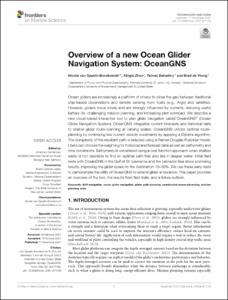| dc.contributor.author | von Oppeln-Bronikowski, Nicolai | |
| dc.contributor.author | Zhou, Mingxi | |
| dc.contributor.author | Bahadory, Taimaz | |
| dc.contributor.author | de Young, Brad | |
| dc.coverage.spatial | Gulf of St Lawrence | en_US |
| dc.coverage.spatial | Labrador Sea | en_US |
| dc.date.accessioned | 2022-03-31T21:28:27Z | |
| dc.date.available | 2022-03-31T21:28:27Z | |
| dc.date.issued | 2021 | |
| dc.identifier.citation | von Oppeln-Bronikowski, N., Zhou, M.,
Bahadory, T. and de Young, B. (2021)
Overview of a new Ocean Glider
Navigation System: OceanGNS.
Frontiers in Marine Science, 8:671103, 14pp. DOI 10.3389/fmars.2021.671103 | en_US |
| dc.identifier.uri | https://repository.oceanbestpractices.org/handle/11329/1910 | |
| dc.description.abstract | Ocean gliders are increasingly a platform of choice to close the gap between traditional
ship-based observations and remote sensing from floats (e.g., Argo) and satellites.
However, gliders move slowly and are strongly influenced by currents, reducing useful
battery life, challenging mission planning, and increasing pilot workload. We describe a
new cloud-based interactive tool to plan glider navigation called OceanGNS© (Ocean
Glider Navigation System). OceanGNS integrates current forecasts and historical data
to enable glider route–planning at varying scales. OceanGNS utilizes optimal route–
planning by minimizing low current velocity constraints by applying a Dijkstra algorithm.
The complexity of the resultant path is reduced using a Ramer-Douglas Pueckler model.
Users can choose the weighting for historical and forecast data as well as bathymetry and
time constraints. Bathymetry is considered using a cost function approach when shallow
water is not desirable to find an optimal path that also lies in deeper water. Initial field
tests with OceanGNS in the Gulf of St. Lawrence and the Labrador Sea show promising
results, improving the glider speed to the destination 10–30%. We use these early tests
to demonstrate the utility of OceanGNS to extend glider endurance. This paper provides
an overview of the tool, the results from field trials, and a future outlook. | en_US |
| dc.language.iso | en | en_US |
| dc.rights | Attribution 4.0 International | * |
| dc.rights.uri | http://creativecommons.org/licenses/by/4.0/ | * |
| dc.subject.other | Ocean glider | en_US |
| dc.subject.other | AUV navigation | en_US |
| dc.subject.other | Glider path-planning | en_US |
| dc.subject.other | Mission planning tool | en_US |
| dc.title | Overview of a new Ocean Glider Navigation System: OceanGNS. | en_US |
| dc.type | Journal Contribution | en_US |
| dc.description.refereed | Refereed | en_US |
| dc.format.pagerange | 14pp. | en_US |
| dc.identifier.doi | 10.3389/fmars.2021.671103 | |
| dc.subject.parameterDiscipline | Physical oceanography | en_US |
| dc.subject.dmProcesses | Data acquisition | en_US |
| dc.bibliographicCitation.title | Frontiers in Marine Science | en_US |
| dc.bibliographicCitation.volume | 8 | en_US |
| dc.bibliographicCitation.issue | Article 671101 | en_US |
| dc.description.sdg | 14.a | en_US |
| dc.description.eov | N/A | en_US |
| dc.description.frontiers | 2021-11-17 | |
| dc.description.adoption | Novel (no adoption outside originators) | en_US |
| dc.description.methodologyType | Reports with methodological relevance | en_US |
| obps.contact.contactname | Nicolai von Oppeln-Bronikowski | |
| obps.contact.contactemail | nbronikowski@mun.ca | |
| obps.resourceurl.publisher | https://www.frontiersin.org/articles/10.3389/fmars.2021.671103/ | |
 Repository of community practices in Ocean Research, Applications and Data/Information Management
Repository of community practices in Ocean Research, Applications and Data/Information Management

